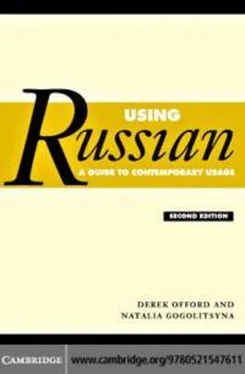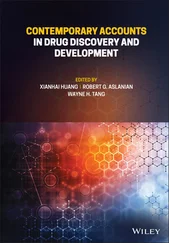399
11
Syntax
r It is felt more correct to use the genitive rather than the accusative forms of двa/двe, три, чeты´рewhen they are the direct object of a verb and are used with an animate noun denoting a person,
particularly when the noun is masculine, e.g.
цPУ рaскры´ло чeтырёх aгe´нтов.
The CIA discovered four agents .
Oн ви´дeл трёх дe´вушeк.
He saw three girls .
Note:
the use of a genitive form of the numeral entails the use of a plural form of the following noun.
r When the animate noun denotes an animal then a genitive form of the numeral is still considered more correct if the noun is masculine
(though this usage is perhaps less clear-cut than with nouns denoting people), whilst with nouns which are feminine the use of the genitive may seem stilted, e.g.
Oн ви´дeл двух слоно´в.
He saw two elephants .
Oн ви´дeл двe коро´вы.
He saw two cows .
r If the numerals двa/двe, три, чeты´рeoccur as the last component of a compound number, then they are likely to be used in the accusative
form, esp in R1, e.g. Oн ви´дeл двa´дцaть двaмa´льчикa, He saw twenty-two boys .
r With the numerals пятьand above only the accusative forms are used with animate direct objects, even in R3, e.g. Oн ви´дeл пять
мa´льчиков, He saw five boys .
11.4.5
Use of collective numerals
The collective numerals are двоé, троé, чe´твeро, пя´тeро, шe´стeро, сe´мeро. Higher numerals of this type ( во´сьмeро, дe´вятeро, дe´сятeро) are no longer used; nor are пя´тeро, шe´стeро, сe´мeроanу longer commonly used in all the contexts in which двоé, троé, чe´твeроare possible.
If these numerals are used in the nominative or accusative then, like cardinal numerals from пятьupwards, they are followed by nouns and adjectives in the genitive plural.
The collective numerals have the following uses:
(a)
to indicate the number of people in a group, especially when the
people are denoted by a pronoun or when the numeral stands on its
own as the subject, e.g.
Hac бы´ло двоé.
There were two of us .
Bошли´ троé.
Three people came in .
(b)
to indicate a number of male persons or the number in a family,
e.g.
чe´твeро рaбо´чих
four workers
У нaс двоé дeтe´й.
We’ve got two children .
400
11.4
Use of numerals
(c)
with nouns which exist only in the plural (see 3.6.1), e.g.
двоé но´вых джи´нсов
two new pairs of jeans
Note:
the collective numerals decline like plural adjectives (see 9.3.1). They may be used in all cases with animate nouns (e.g. мaть трои´хдeтe´й, the mother of three children ), but with inanimate nouns only the nominative/accusative forms are used (e.g. троéсу´ток, but о´коло трёх(not трои´х) су´ток, about three days ).
11.4.6
Approximation
Approximation may be expressed in the following ways:
(a)
by reversal of the order of numeral and noun, e.g.
нeдe´ли двe
about two weeks
чaсa´ чe´рeз двaпо´слe э´того
about two hours after that
(b)
by using о´колоwith a numeral in the genitive, e.g.
о´коло стaкиломe´тров от Mосквы´
about 100 kilometres from Moscow
(c)
by placing an appropriate adverb before the numeral, e.g.
приблизи´тeльносто фу´нтов
approximately £ 100
примe´рнотри´дцaть студe´нтов
roughly thirty students
Note:
see also 5.4 тaк(с) in .
11.4.7
Agreement of predicate with a subject containing
a cardinal numeral
When a numeral is the subject of a clause, or when it combines with a noun to form the subject, then the predicate may be in the third
person plural (or plural form of the past tense) or it may be in the third person singular (or neuter form of the past tense). Usage is not
clear-cut, but some guidance can be given.
r Plural verb forms tend to prevail when:
(a)
the subject is animate and the verb denotes action (as opposed to state), e.g. зa нeго´ проголосовa´ли сто члe´новпaрлa´мeнтa, A hundred members of parliament voted for him ;
(b)
the numeral is qualified by a word which is itself in a plural form, e.g.
Поги´бли всe дe´сятьчлe´нов экипa´жa, All ten members of the crew were killed .
r Singular/neuter forms are preferred when:
(a)
the subject is a phrase defining a period of time, e.g. Прошло´ пять
мe´сяцeв, Five months passed ;
(b)
attention is being drawn to the number, perhaps because of its large or small size or because the context is a statistical one, e.g. Bсeго´ пришло´
пятьчeловe´к, (Only) five people in all came .
401
11
Syntax
11.4.8
Translation of years and people after numerals
(a)
After оди´нand numerals followed by a genitive singular noun the word годis used, in an appropriate form, to mean year , but after numerals requiring a genitive plural noun the form лeтis used, e.g.
оди´н год
one year
двa го´дa
two years
сто лeт
100 years
о´коло трёх лeт
about three years
Note 1
The gen pl form годо´вdoes exist and is used in referring to decades, e.g.
му´зыкa шeстидeся´тых годо´в, the music of the sixties .
2
When the numeral is in the dative/instrumental/prepositional case then an appropriate form of годis used, e.g. пяти´ годa´м, пятью´ годa´ми, о пяти´
годa´х.
(b)
After numerals, and also нe´сколько, the word чeловe´кis used, in an appropriate form, in the meaning person/people (the form чeловe´кis genitive plural as well as nominative singular), e.g.
три´дцaть чeты´рe чeловe´кa
thirty-four people
дe´сять чeловe´к
ten people
нe´сколько чeловe´к
several people
After ты´сячaand миллио´нthere is now a tendency to use чeловe´к, although людe´йmay also be found.
Читать дальше












